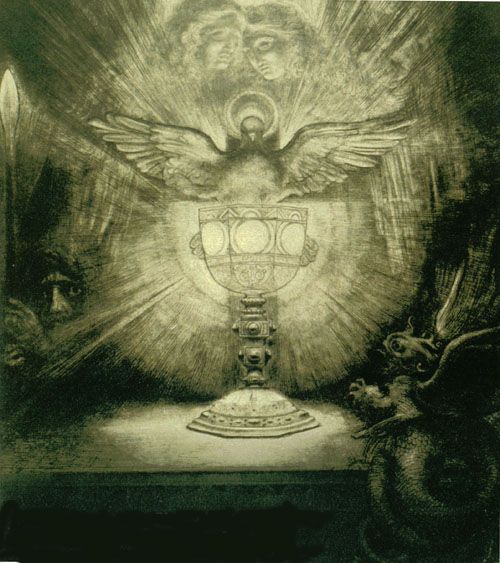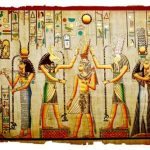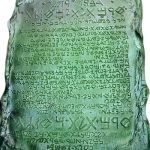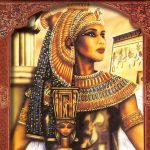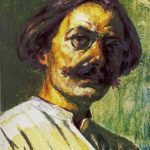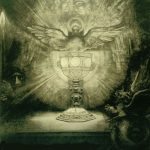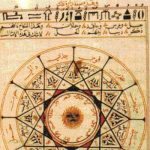Chapter Ten
Having examined the first thousand years of alchemy’s history, it’s time to take stock of what we have discovered. The earliest surviving alchemical texts all have pre-Christian Gnostic associations. The Emerald Tablet inclines toward Greco-Egyptian Gnosticism as its source, while the “Isis the Prophetess” story suggests an Egypto-Hebraic origin. The connection point is ancient Egypt.
Zosimus informed us that alchemy derived from the wisdom of the pre-catastrophe offspring of semi-divine beings and humans. In ancient Egypt, these beings were known as the Hru Shemsu, or the Company of Horus, the Follower’s of the Widow’s Son. The “Isis the Prophetess” story is our last unitary text of the ancient wisdom. In it, we can identify the major alchemical themes and preoccupations of the next two thousands years, which can be expressed simplistically as the triple transformation. Alchemy, as “Isis the Prophetess” tells us, is composed of an interior, psycho-sexual transformation, an exterior elemental transformation of matter and a transformation of time itself.
In the collapse of the ancient world, this unitary view of alchemy fragmented into several parallel currents. The physical transformative process was seen as separate and became confused with metallurgical and proto-chemical trickery. The internal transformation became the basis for the experiential mysticism, or gnosticism, of Christianity, Judaism and Islam. The secret of the transformation of time, the advent of the kingdom of heaven, became the inner core of early Christianity. Unfortunately, this vision was co-opted and debased by the Imperial Church into an on-going apocalypse against heretics. In Judaism, the secret of time was intimately intertwined with the work of creation, the ability to animate matter. As we saw in the Bahir, Jewish mysticism retained intact a major portion of the secret.
With Islam, the split began to widen even further. The secret of time, which lay at the core of Mohammed’s revelation, was retained as a family secret among the descendants of the Prophet. The internal transformative processes became the mystical practices of the Sufis, while the external transformation of the elements became one of the cornerstones of Islamic science, along with medicine, astronomy and mathematics. Within Islam, threads of all three transformative processes can be found, but never as one unitary system.
By the later half of the 10th century, this separation had reached a kind of maximum dispersion. The secrets of the Bahir were known only to a few small groups of Jewish mystics, mostly in Spain and Palestine. The Islamic mystics were just forming the early Sufi orders, while the Shi’ite owners of the inner secret were trying to conquer the Islamic world. Christianity of course had persecuted its alchemists and Gnostics out of existence, leaving a shroud of darkness over the entire 700 year period from the fall of Rome to the Crusades.
Learning in the west sank to a level little above superstition. Such scholars as there were, Pope Gregory the Great (490-504) for instance, dwelt mainly on ecclesiastical matters with an amazing credulity for tales of marvels, miracles and the possession of man by demons. Beyond such writings, there were only confused compilations from fragments of classical authors, variously and often wrongly ascribed. These were the crumbs of ancient wisdom that nourished that dark and arid age.
This sad state of affairs began to change when the Moslem Arabs and Moors entered Spain from North Africa in the 8th century. Islam, seemingly endowed with an insatiable curiosity for foreign learning and guided by a truly Oriental imagination which contrasted sharply with the passive intellectualism of the west, revitalized the civilization of the territories it conquered. Europe was saved from this fate by Charlemagne’s grandfather, Charles the Hammer, at the battle of Tours in 732. But Spain became a Moslem stronghold.
In the centuries that followed the Arab rise to world power status, its leaders, caliphs and sultans and generals, exhibited a great interest in learning and arranged for the literature of the conquered areas to be translated into Arabic. Much of the ancient wisdom was preserved in these Arabic translations. The writings of Aristotle, Archimedes, Appolonius, Euclid, Hippocrates and Galen were all saved for the west, where the knowledge had disappeared, by these Arabic collections. It was also through these Arabic sources that knowledge of alchemy was re-introduced to the west.
We have already mentioned Jabir, an 8th century collector and interpreter of Gnostic alchemical texts, but of perhaps even more significance is the treatment given to the Hermetic arts in the great 10th century Arabic encyclopedia, Kitab-Fihirst. Several pages are devoted to various Hermetic subjects, including mentions of the Egyptian Chemes, the pre-catastrophe founder of alchemy, Hermes Trismegistos, Mary the Jewess, Cleopatra and Stephan of Alexandria. The Arabs, at the close of the 10th century, created a perspective on alchemy that colored its subsequent development down to the 20th century.
Moslem Spain served as the transmission point between Islam and Christianity. As the tide of conquest receded, pockets of Christianity remained and slowly formed into Christian kingdoms. Along with the religious and political struggles, this close contact provided a convenient means of communication. After the Fatimids conquered North Africa in the 10th century, Arab Spain found itself even more isolated from the centers of Moslem life. The Spanish caliphs of the late 10th and early 11th centuries were concerned with staying even with or ahead of their Fatimid rivals, particularly in terms of culture and learning. It was from Spain, then, that Europe drew the energy and knowledge needed to re-animate its civilization.
* * * * *
Largely as the result of the efforts of one individual, Pope Sylvester II, by the early years of the 11th century things had begun to change. Fueled in part by the apocalyptic yearnings centered around the thousand year anniversary of Christ’s death (popularized by Sylvester’s student, Rodulphus Glaber), the Christian west began to stir itself. The Church of Rome tried a few reforms, driven by the new and growing monastic and Peace of God movements. But most significant of all, waves of pilgrims took the long and dusty road to Jerusalem.
Pilgrimage, journeys of repentance and spiritual seeking, had long been an important part of popular Christianity. But, before the middle of the 11th century, pilgrimages to the Holy Land were rare. Starting around the magical year of 1033 (one thousand years after Christ’s death) and continuing in an ever-increasing wave for the next 40 years, Jerusalem became the pilgrimage destination of choice. In 1071, the Seljuk Turks conquered Palestine, wrenching the Holy Land from the control of the Egyptian Fatamids who were sympathetic to the Christian pilgrims. The Turks however, were not so accommodating. By the early 1080’s, pilgrimage to Jerusalem had all but stopped. The few pilgrims that were allowed to visit the Holy City were harassed, robbed and generally treated as unwanted outsiders.
Most authorities tell us that this was the motivating factor behind the crusading movement that would burst over Europe after Pope Urban II’s call in 1095. The pilgrim impulse, by some sort of religious transformation, turned into a Holy War. While there is a core of truth in this simplification, the real causes of the First Crusade are shrouded by the secrecy of deep political intrigue. From our thousand year distance, these shadows are almost impenetrable. However, like the sudden appearance of a star through the murk of a cloudy midnight, certain events and personalities shed an uncertain light on the outlines of the Crusades’ political intrigues.
The most important of these events were the political conjunctions between east and west begun by the Pope, the Emperor and the Caliph one hundred years before the First Crusade was announced. While it is true that the First Crusade was a pilgrim movement with Jerusalem as its focus, it was also much more. It was part of a vast plan conceived and carried out by a group of secret societies for the purpose of creating a world state in the Holy Land and thereby bring on the Chilaist millennium of peace.
At the core of all the intrigue, the secret at the heart of the secret societies, lies alchemy. The Arab scholars and scientists had preserved the ideas and some of the basic texts, but the re-discovery of the secret of how to make it work was the main result of the First Crusade’s conquest of Jerusalem. To tell this deeply hidden story we must go back a few hundred years and trace the tale of the Emperor, the Pope and the Caliph and the true origins of the crusades.
* * * * *
The political and religious processes that led to the First Crusade actually began three hundred years before, with the rise of the Ismaili sect of Shi’ite Moslems. Within the Shi’ite community, each generation of Ali’s descendants was headed by an Imam, or incarnation, who was the holder of the family secret, the secret of time at the heart of Mohammed’s revelations. In the mid-eighth century, the sixth Imam, Jafar al-Sadiq, appointed his son Ismail to succeed him. Ismail however was not saintly enough (he reportedly had a taste for wine), and his father rescinded his appointment and named his other son Musa as Imam.
To some, this was unacceptable. They believed that once an Imam always an Imam, and therefore Ismail was the seventh and last true Imam of the Shi’ites or adherents of the family of the Prophet. For a hundred years after the break, the Ismailis remained a marginal sect of the Shi’ites. But around the middle of the ninth century, Abdallah ibn Qaddah became the leader of the group and instituted far reaching changes. He sent missionaries throughout the Moslem world preaching the doctrine of the “Seveners” as they were called. These missionaries were also members of a secret society.
Abdallah had organized the Ismalis into a grand lodge, with nine levels of initiation, called veils, leading up to the Secret Doctrine, or the Talim. (Note that this title for the secret knowledge is from the same root as talah and Teli, and literally means “suspended,” or “hanging from.”) The initiate swore an oath of secrecy and absolute obedience to the Dai-d-Duat, or Grand Master of the sect and was told that attaining the ninth degree of initiation would render him above all creeds and laws. The eighth degree taught that nothing could be known of the supreme being and that no worship of such an exalted entity was possible. From this we can speculate that the ninth degree revealed the inner secret of time and the Teli, or dragon-axis of the universe.
Abu Abdallah, the founder of the Fatimid Dynasty, was a member of the Ismaili secret society, and the inner teachings of the Seveners became the core of the Fatimid Grand Lodge of Cairo. While the Fatimids consolidated their control over North Africa and Egypt, another Ismaili group seized power in Iran with the intention of re-creating the Persian Empire along Ismaili lines. This movement burned itself out by the mid 10th century, but not before it had conquered Meccah and carried off the Black Stone itself. The Stone was presented to the Fatimid Caliph al-Mansur, who restored it to the Kaaba in 951.
After this, the Fatimids rose swiftly to dominate the Moslem world, conquering Egypt and Palestine and threatening Syria. As their power grew, the Fatimids increasingly turned to mysticism, science and the secret tradition for guidance. The late 10th century saw the founding of Al-Azhar Mosque and its Hall of Wisdom. The Fatimid astronomers were the most accomplished of their day. Alhazen may in fact have secretly invented the telescope. He certainly knew the optics required for such a construction, and his charts on the movements of the planets, the inclination of the ecliptic and the precession of the equinoxes remained invaluable down to the re-discovery of the telescope in the 17th century. Part of this knowledge could have been derived from the secret tradition of the Ismaili Shi’ites.
* * * * *
As the Fatimid influence spread in the 10th and 11th centuries, some of this knowledge began to reach Europe through the schools of Moslem Spain, where science and civilization had reached a level that was almost unimaginable by European standards. The best minds of Europe traveled to Spain to study everything from music to medicine to astronomy. One such student, Gerbert of Aurillac, the future Pope Sylvester II, shines out of the murk of the Dark Ages. It was Gerbert’s efforts that almost single-handedly pulled the Christian west out of its dark age stupor.
Gerbert’s life is an example of how a poor intellectual prodigy could rise to the very top of early medieval society. He was born around 940 in Auvergne and at an early age entered the nearby monastery of Aurillac. At the abbot’s insistence, Gerbert was sent to Spain to study mathematics.
Spain at this time, the mid-960’s, was at the peak of its civilization. The Caliph Hakam II, son of the triumphant Abd-er-Rahman who forged Moslem Spain into a world power, surpassed every one of his predecessors in the love of literature and the sciences, we are told by the Moslem historian al-Maqqari. He turned all Andaluz, Moslem Spain, into a market where the wisdom and learning of the whole ancient and medieval world could be found. It was into this environment that the young prodigy, Gerbert of Aurillac found himself submerged.
He must have done very well indeed, because we find Count Borel of Barcelona introducing him to the Pope in 970. Pope John XIII, one of the few Popes of the period who seemed sincere and managed to die of old age instead of assassination, was so impressed by Gerbert’s erudition that he recommended him to the up and coming world political power, Otto I, Emperor of the Roman West, and the Charlemagne of Germany.
To discuss the political history of the west from the Fall of Rome to the Crusades would make this already overlong narrative collapse of its own weight. From the point of view of our exploration of alchemy, the Dark Ages are truly dark. However, the fall of Rome and the subsequent events in Europe do effect our examination of the end of the world.
After Constantine, it was no longer heretical for Christians to look to a World Ruler as the divine solution to political problems. The Empire of Rome became the Kingdom of God, officially, and this required a shift in the myth of the apocalypse as presented by John’s Revelation. This was supplied by the retro-prophecy of the various Sibyls. These Sybilline Oracles, popular from the 4th through the 10th century — some having an influence all the way down to Nostradamus in the 16th century — introduced a brand new apocalypse myth, that of the Emperor of the Last Days. In this view, the world would last as long as the Empire did, therefore the world needed an Emperor to exist.
Charlemagne, at the turn of the 8th and 9th centuries, was the first of the formerly barbarian leaders to play this card. With the fraudulent “Donation of Constantine,” which supposedly invested the Church of Rome with the power to appoint an Emperor, the Church and the State entered into an uneasy alliance that would effect European politics and society for half a millennium. It was this dynamic that allowed Gerbert to move so smoothly into the highest ranks of power after meeting the King of Germany and the new Holy Roman Emperor of the West, Otto I.
Various treaties in the 9th century had made Ludwig, a grandson of Charlemagne, the first king of Germany and defined its boundaries as the territory between the Rhine and the Elbe, with a few extra morsels around the edges. After 70 years of discord, Otto I, a true scion of Charlemagne in looks and temperament, became the King of Germany. At his coronation, Otto surrounded himself with the nobility of the neighboring countries, creating at the very beginning of his reign a sense of trans-national importance. No wonder he soon began to see himself as the restorer of the western Empire.
In the first 15 years of his reign, Otto strove by any means possible, from war to murder to marriage, to accomplish this goal. In 962, Pope John XII crowned Otto as the Holy Roman Emperor of the West. Within a year of his becoming Emperor, Otto had marched into Italy and made it a part of the new Holy Roman Empire, which was of course, a mere appendage of the German Crown. This was the new world power to whom the young and scholarly Gerbert was introduced in 970.
For the next 33 years, Gerbert would be the spiritual advisor and mentor to all three Otto’s. His vast learning and command of all three diplomatic languages of his day, Latin (which he wrote with an elegance not seen since Sidonius in the fifth century) Greek and Arabic, made him invaluable in the diplomatic intrigues of the new Imperial court. From the mid-970’s to his death in 1003, Gerbert would remain at the center of the changes sweeping through the west.
During the year he served as tutor to the young Otto II, Gerbert also helped Otto I arrange a marriage between the Greek Emperor’s daughter, Theophano, and his student. This would make their son, the future Otto III, the heir of both halves of the old Roman Empire. This was the first of many such ventures into power politics by Gerbert. It may have been Otto I who was dreaming of a united Roman world, but Gerbert would come to dream of bigger things.
Hard on the heels of the successful conclusion of the marriage negotiations and the wedding, Gerbert was dispatched, at his own request, to Rheims, the ancient and royal cathedral town of Charlemagne, where every King of France (from Clovis I in the 5th century to Louis XVI in the 18th) was crowned. Soon after his arrival, he was appointed head of the cathedral’s school by Otto II in appreciation for his diplomatic efforts. He held this post for a decade, and during that time he collected manuscripts from around the world, wrote works on the astrolabe, Arabic astronomy, and geometry.
Gerbert was instrumental in beginning what would become known after his death as the Peace of God movement, and wrote to other scholars and prelates in the late 970’s discussing how to limit warfare and bring peace to Christendom. Working with the Archbishop of Rheims, Adalbero, Gerbert organized a series of church conferences in the 980’s which instituted a Truce of God type arrangement. War was permitted only on certain days and only under strict conditions. The peasantry, which suffered the most from feudal warfare, enthusiastically embraced the concept.
Gebert left his post as master of the cathedral school at Rheims in 982 to work full time on the peace movement. During this period we also find him writing letters to various other cathedral schools promoting the development of libraries and encouraging the addition of Greek and mathematics to the curriculum. But Gerbert’s opportunity to return to power politics arrived in 987 with the death of the last Carolingian king of France, Louis V. The unhappy Louis left no heirs, so the choice was between Charles of Lorraine, Louis’ brother and a distant off-shoot of the Carolingian line, and the best candidate from the previous dynasty, the Merovingians.
This obscure Dark Age dynasty was made famous by the speculations in Holy Blood, Holy Grail that it was in fact founded by the descendants of Jesus and Mary Magdalene. There is enough evidence in support of this contention to make us wonder just how their contemporaries saw them.
Medieval tradition reports that the Merovingians had a supernatural origin. Gregory of Tours, the foremost Frankish historian, tell us that Merovee, the founder of the dynasty, was the son of two fathers. The first king of the Franks, Chlodio, was one father. The other was a strange sea creature, “similar to a Quinotaur” according to Gregory of Tours, who impregnated his mother while she was out bathing in the ocean. From this, he was given the name Merovee, “son of the sea.” Merovee is also “son of the mother” and “son of Mary.”
Strange titles for a barbarian and pagan king. His son Clovis I became ruler over a united Gaul and eventually, fter much prayer on the part of the hermit monk St. Remy, converted to orthodox Christianity. This alliance helped stabilize the western church. For 250 years, the Merovingians ruled as a kind of priest-king, strangely above and exempt from the censure of the church it supported. The actual government was handled by their “mayors of the palace.” In the end, it was one of these Mayors, Charlemagne’s great grandfather, Pepin the Short, who finished off the main line of the Merovingian dynasty.
But other Merovingian lines had survived, most prominently that of Neustria, the Merovingian kingdom that included Rheims and Paris. Descendants of the Merovingian kings had remained in control of the region as its Dukes and even as the Mayor of Paris. It was almost inevitable that when the Carolingian line died out that the kingship would revert to a descendent line of the Merovingians.
This issue was decided by a church council called by the Archbishop of Rheims, and organized by Gerbert of Aurillac. Gerbert may in fact have done the research to prove Hugh Capet’s claim to Merovingian ancestry. The council found that Hugh Capet’s family were indeed descendants of the last King of Neustria, and therefore unanimously elected him the new King of France. Archbishop Adalbero, in announcing the decision, proclaimed that Hugh should be king not just because Charles was “neither honorable nor strong,” but because only Hugh could restore the rightful balance between the king, the land and the people. “If you wish ill to our country,” Adalbero preached, “choose Charles. If you wish prosperity, choose Hugh. . .”
And the council chose Hugh. He immediately consolidated his authority by making his son co-ruler, thereby insuring the continuity of power in case something unfortunate should happen to him. Hugh Capet was not only of the right bloodline, but he was also wise to the ways of politics in the 10th century.
The next year Adalbero died and Gerbert rightly believed that he should be his successor as Archbishop of Rheims. Hugh Capet, ever the politician, gave the Archbishop’s post to Arnulf, a bastard son of the Carolingian line. Hugh meant no insult, it was just politics. However, it was politics that backfired. Arnulf plotted against Hugh, and in 991, a French church council deposed him and put Gerbert in his place.
For the next four years, Gerbert used his position as the Archbishop of Rheims to support the growth of the peace movement. He also founded a variety of clerical orders — known collectively as the Chroniclers, or the chronicling orders — and libraries in places far distant from Rheims, including Provence, Aquitane, Lorraine and Calabria in northern Italy. During this time however, the French church was fighting a fierce internal war with the current Pope, John XV, over the right to depose an Archbishop.
Faced with excommunication over the issue, Gerbert stepped down from the Archbishop’s post, and moved from Rheims to join the young Otto III’s emerging court in Germany. In 996, Otto III reached his majority and took over the government, with Gerbert of Aurillac by his side. John XV, in trouble as the Pope almost always was in those years with the Roman nobles, appealed to Otto III for help. Otto marched south from Germany, but at Pavia, in northern Italy, word reached him that John XV had died. Otto, not thinking much of the Papacy at that point, appointed his cousin, a chaplain named Bruno, to be Pope Gregory V.
Gregory V was a young idealist committed to reforming the church, and in his brief two and half year reign as Pope of Rome he tried his best. Unfortunately, pious Gregory was not as politically astute as Hugh Capet, and his chief rivals, the patrician Roman “mafia” of the day survived with hardly a disruption of their power base. (There really is no other way to refer to the strong arm tactics and ethic of personal power that animated the “republican” nobles who really controlled Rome in the absence of an Imperial army.)
As soon as Otto III departed, Crescentius, the Godfather of the Romans, threw Gregory V out and went looking for an anti-Pope. Unfortunately for the Godfather, he settled on a Greek Bishop named Philagathus. It seems that Philagathus, a career diplomat/spy, had just arrived in Rome from a trip to Constantinople to arrange a Greek marriage for Otto III. Crescentius was attempting an end-run around Otto III’s cherished dream of reuniting the Empire, a very dangerous thing to do, as it turned out.
This time when he returned to Rome, Otto was mad. A considerable blood bath ensued. Philagathus was caught, blinded, mutilated and then paraded through Rome on an ass. Crescentius and the twelve heads of the Roman mob fortified Saint Angelo’s, which was then taken by an assault. All the defenders died, creating a vast Roman underworld power vacuum. Otto III proposed to fill it by permanently moving his capital to Rome.
Gregory V died suddenly the next year, 999, and it was inevitable that Gerbert would succeed him. Gerbert had the support of the Emperor, on the spot with his troops, as well as that of the Abbot of Cluny, the leading force in both the reform movement and the peace of God movement. Gerbert saw this as the fulfillment of a long held dream and fully supported his young prot?g? in his Imperial designs. He became Pope Sylvester II, taking the name of Constantine’s Pope to emphasis the similarity between the two Emperors.
With the Emperor’s support, Gerbert, or Pope Sylvester as we will now call him, plunged into a whirlwind of far reaching negotiations. He expanded the reach of the Catholic church into eastern Europe, adding the area of Poland, Czechoslovakia and Hungary by creating Archbishops and converting Kings. Vajk, the Magyar King of Hungary, was baptized as King Stephen, and eventually became a saint. For this, Sylvester sent him a Holy Crown to symbolize his Christian kingship.
* * * * *
In addition to converting Eastern Europe (perhaps as a bulwark against the press of Asiatic refugees, Jews, Kazars, Turks and so on, being pushed westward out ahead of the early Tibetan/Mongolian invasions), Sylvester was also interested in converting Islam. With that in mind, he made a diplomatic contact with the Fatimid Caliph al-Hakim, in the year 1000 (which is, in the Jewish calendars, year 1311 of the Seleucid Era, 932 Huban or years since the destruction of the Temple, and 4760 Anno Mundi or years of the world since creation; in the Moslem calendar, it is 391 years after the Hajira from Meccah to Medina).
The early Fatimid Caliphs became fabulously wealthy after conquering Egypt in the later half of the 10th century. Al-Hakim ibn Aziz, who became Caliph in 996, the same year Otto III became Emperor, inherited his wealth and power. In the end it was perhaps, along with other pressures, more than he could bear. He went mad, declared himself a god, and died, disappeared or was assassinated some time after 1021. But during his reign, far reaching changes occurred.
Al-Hakim supported the Al-Ahazar mosque and its growing university. He founded the Hall of Wisdom, hired Mohammed ibn al-Haitham, the probable inventor of the telescope, and helped Ali ibn Yunus publish his astronomical tables. As much as diplomacy, it was these subjects that Sylvester wanted to discuss. Al-Hakim, a ninth degree Ismaili initiate, might just have had something to share with the brilliant Pope.
Sylvester arranged with the Fatimid Caliph, in 1001, for a group of clerics and knights from his various chronicling orders to make an expedition to Syria and the Holy Land. Various historians have from time to time pointed to this as the first wave of Crusaders, and just as quickly remarked on their lack of aggressive zeal. Pope Sylvester’s Chroniclers, we are told in a 12th century Papal sermon by John XIX (a Roman mafia pawn), disappeared without accomplishing anything, except to serve as vassals of the Caliph. Implying of course that they converted to Islam.
Al-Maqqari, the foremost Moslem historian of the 12th century, tells us that al-Hakim greeted the Pope’s entourage with honor and spent many weeks in Jerusalem discussing the virtues of Islam versus Christianity with them. He was so impressed by their sincerity that the Caliph gave them, in 1002, the use of a Byzantine Greek church on the outskirts of Jerusalem for their chapter house and library. Unfortunately, al-Maqqari doesn’t name the entourage or the location of their order, merely that they were there as chroniclers or historians.
These were hardly Crusaders. The Moslem authorities do not record that they converted to Islam, but that al-Hakim honored them as Christians. They came not to conquer Jerusalem but to do research. We can only speculate on what.
By the time his delegation had established itself in Jerusalem, Sylvester himself had been forced out of Rome by the old problem of political terrorism. From northern Italy, Sylvester and Otto III struggled with a crumbling political situation. In 1003, they both, within a few months of the other, died under suspicious circumstances. The dream of a united Roman Empire, as some kind of universal world state, appeared to die with them.
* * * * *
But in fact, it merely went underground for a few generations. To see this, we must look at Sylvester’s legacy and his legend. Combining these perspectives allows us to glimpse the outlines of a far reaching plan and even to note the shuffling of ideas and events behind the official explanations. Sylvester died before the plan began to bear fruit, but the harvest would eventually bring a Christian King of Merovingian descent to the throne of Jerusalem.
The most significant of Sylvester’s legacies was the Peace of God movement which would inspire both the First Crusade and the newly emerging popular heresies, such as the Cathars and the Bogomils. Church councils and lay preachers spread the idea throughout the west in the century after Sylvester’s death, preparing the way for the call to crusade. Both the Peasant’s Crusade and its leader, Peter the Hermit, had their origins in the Peace of God movement. Peter the Hermit, as we will examine in the next chapter, may in fact have had connections with Sylvester’s shadowy group of monks and chroniclers.
One of these monks, Richer of the Order of St. Remy (the saint who converted Clovis I to Christianity) has left us a portrait of Sylvester’s teachings that contain the spark of the legend. Richer tells us, among a list of Gerbert’s accomplishments, that he had long studied the Hermetic arts. From this remark grew the legend of an alchemist Pope.
One of the most persistent stories, first told in the 13th century, has Gerbert, while still Archbishop of Rheims, constructing a magickal bronze “head” that foretells the future. The “head” of course announces that Gerbert will indeed be Pope, which, considering his shaky position as Archbishop, was a bold prediction. A similar story of a bronze head would be told about other medieval magicians, including Roger Bacon and Albertus Magnus. It also suggests, in an indirect way, the “head” the Templars were supposed to have worshipped, the mysterious Baphomet.
These similarities are not accidents, but glimpses of the design behind the symbols. Richer, in his Histories, gives us the clue. In the sentence after he mentions Gerbert’s Hermetic accomplishments, Richer informs us that Gerbert had also designed an armiliary sphere with which he could determine the location of the sun and the planets in relation to the celestial sphere. Interestingly enough, the earth in this model was round, five hundred years before Columbus.
Later, as Pope, Sylvester designed and commissioned a new armilary sphere incorporating the information in Ali ibn Yunus’ tables. The new sphere showed the plane of the ecliptic, the milky way, and the ecliptic and planetary poles. It was, in simple terms, a bronze machine for calculating the secret of time, alchemy’s third and most important component. In symbolic terms, this became the “head” possessed by all famed students of the art in the middle ages.
The mysterious name of the Templar’s “head,” to briefly jump ahead of our story, confirms this assumption. Baphomet, in Arabic, Aramaic and Hebrew, is simply “bet’ amet,” or “place of truth.” The root ba or bet is the same as the ba in Baal, and can signify a house, a place, or the action of filling space. The “place of truth” used as a title could well be meant to signify the space filling “house” of the celestial sphere and the truth of its temporal indicators. Over time, the simple phrase became a code word for the secret itself. The Templars did not worship their bronze head, they meditated on it and studied it closely for clues about the secret of time and the timing of their alchemical processes.
Another of Sylvester’s chronicling monks, Rodulphus Glaber, jump started the pilgrimage movement with his fanciful account of the millenarian activities surrounding the year 1033, the one thousandth anniversary of Christ’s death. While not completely true, we might call it propaganda today, Glaber’s tale of cosmic portents and massive pilgrimages to Jerusalem gave voice to the anxieties of its age. A great desire arose in all classes of society to participate in the on-coming millennium, not just wait passively for its arrival. It was this feeling that animated the First Crusade. Conquering Jerusalem brought the millennium one step closer.
As Sylvester’s legacy and his legend intermingle, we begin to see the outlines of the great plan. Looking back, we can discern, through the mists of obscurity, the thread of meaning behind the events of Gerbert’s life and the hectic activity of his Papacy. Having sorted through the historical record, we must now venture into interpretation for a more complete understanding.
Gerbert studied in Spain and absorbed there his ideas on mathematics, astronomy and geometry, subjects required for an understanding of the secret of time. Something he learned, either in Spain or during his negotiations with the Greek Emperor’s courtiers, led him to choose Rheims as his homebase. The importance of the ancient town of Rheims lies in its association with St. Remy and Clovis I, its connection that is with the ancient Merovingian rites of kingship. While at Rheims, Gerbert orchestrated the transfer of royal power from the Carolingian usurpers back to the rightful line of kings, the mysterious Merovingians. The dynasty he initiated, and its collateral branches, would rule France down to the French Revolution.
It is possible that Gerbert, while researching Hugh Capet’s claim, discovered the evidence uncovered by the authors of Holy Blood, Holy Grail and came to believe that the Merovigian line were the descendants of Jesus and Mary Magadelene. Any evidence that did exist would have been preserved among the records of the cathedral at Rheims, where Gerbert would certainly have found them. Possession of this kind of volatile information goes a long way toward explaining the animosity of the Roman Church against Gerbert as Archbishop of Rheims.
Gerbert however used his time as Archbishop in founding libraries and clerical orders devoted to history, genealogy and chronicling. This activity increased after he became Pope and resulted in the so-called first wave of the Crusades, the group of chroniclers welcomed in Jerusalem by al-Hakim. From this perspective, it is not too hard to imagine what they were there to research. Nothing less, we can suppose with some confidence, than the genealogy of Jesus and Mary Magdalene.
As important as this kind of information would have been, there is still more to the story. The Holy Roman Empire of Otto III, who we must remember had a valid claim to be Emperor of both West and East, was poised on the edge of becoming a world state. Something more than the bloodline of Christ was at stake.
The Merovingians, from the earliest kings, had a reputation for wealth that was all out of proportion to their political situation. The grave goods of Childric I, found at Sutton Hoo, are lavish and mostly made from solid gold. Three hundred golden bees were found in his grave, all exquisitely sculpted of pure gold. Napoleon, in the 19th century, had them sewn on his coronation robe as a sign of power and authority.
The key is of course alchemy. The early Merovingian priest-kings understood the secret, the triple transformation of the alchemical process, and could make it work. Merovee, son of two fathers, did much more than found a dynasty. He received, from his spiritual father across the sea, the secret of the triple transformation. If he was indeed “the son of Mary,” that is Mary Magadelene’s descendent, then the secret of alchemy might just have been a family inheritance. Merovee passed the secret to Clovis, his son, who became instantly and fabulously wealthy. Inside of a generation, the Merovingians controlled most of France and western Germany.
The secret was lost after a few generations, and the priest-kings succumbed to the more vigorous Mayors of the Palace, the Carolingians. Gerbert, uncovering the secrets of the Merovingians would also have uncovered the hints as to its alchemical wealth. From his Arabic studies, Gerbert would have known enough of the secret to realize the importance of the Merovingian connection. Hence his obsession with chroniclers and histories. He was searching for the rest of the puzzle.
It is just possible that he found it when he made contact with the Fatimid Caliph al-Hakim. Not only was al-Hakim an Ismaili initiate with the world’s finest observatory and astronomical tables at his disposal, but he may in fact have had an actual piece of the secret.
When we began our research into alchemy and the end of the world, we were amazed to find so many connection to Arabic and Sufi sources, specifically those of the Shi’ite Fatimids and Ismailis. We knew that the Arab scholars had preserved most of the ancient alchemical texts, but somehow, the secret was missing from these works. As we probed deeper into the secrets of the triple transformation, and the secret of time, we realized that the Shi’ites and the Ismailis did indeed have the missing piece.
Mohammed had taught his son-in-law the secret of time, and most importantly, the secret of the timing of the Day of Judgment, the end of the world. The Shi’ites were not alchemists, they used the information as a means of provoking the inner transformation. The Ismailis turned this into a teachable system of grades within a lodge based order. But something was still missing.
And then we noticed an obscure fact. The only time the Black Stone was ever removed from the Kaaba was the work of the Iranian Ismailis in the mid 10th century. The Stone was presented to the Fatimid Caliph of North Africa, Al-Mansur, great-grandfather of al-Hakim, who returned at least a portion of it to the Kaaba in 951.
Our research into the Bahir and the early history of the Kaaba had shown us how significant the Black Stone was to the Abrahamic mysteries of animating matter. As the stone that fell from heaven, it seemed almost a model for the Philosopher’s Stone described in the Emerald Tablet. A philosopher’s stone in Meccah and one in the hands of a Fatimid Ismaili Caliph are two different things, and we were struck by the connection.
The world state of Otto III and Sylvester may been intended to include the marriage of all the royal and spiritual traditions into one Empire based on Jerusalem and financed by alchemy. Since none of the separate players, the Pope, the Emperor or the Caliph had the complete secret, co-operation was required. Before it was accomplished, two of the three principles died under mysterious circumstances.
This left the Caliph holding the bag, or perhaps more correctly, the stone. Al-Hakim sank deeper into his mystical funk and in the year 400 of the Moslem calendar, 1009 in the west, he declared that he had achieved godhood. From this exalted status he took revenge on the Christians and the Jews for their perfidy and betrayals by destroying the churches and synagogues in Fatimid territory. He ruled for 12 more years as a living god and then died or disappeared in 1021, leaving the Fatimid empire in chaos. From the bare facts, we can infer that al-Hakim carried a secret that was much too large for him.
The tale of the Pope, the Emperor and the Caliph remains hidden among the debris strewn by a thousand years of secrecy and internal strife among the holders of various pieces of the secret. Pope Sylvester started a ball rolling that, in a few hundred years, would change beyond recognition the face of European culture. The Crusades opened the east directly to the west, and the hand of Sylvester’s design played a part in all of it. Without Sylvester, there might never have been a Crusade. And, without Sylvester’s Fatimid connections and his chroniclers in Jerusalem, there would certainly never have been an Order of the Knights of the Temple.
The Templars are the point where the deep politics started by the alchemist Pope surfaced into the historical record. The history of the Templars, particularly their mysterious origins and their unaccounted for wealth, provides a myriad of suggestive connections. Without the Templars, there wouldn’t have been any cathedral building movement, or the money to pay for it. From the point of view of our research, without the Templars, there might not have been any such thing as alchemy to investigate.
More Articles from Sangraal.com:
Submit your review | |

